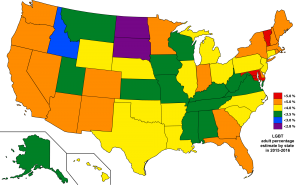Our society centers around the heteropatriarchy, as Gill Valentine explained in her piece “Making Space: Lesbian separatist communities in the United States.” The overwhelming influence of perceived male dominance and heteronormative ideals affects all non-male people negatively. toValentine ventures to say that “heterosexuality is the root of all women’s oppression” (110). This appears to be an extreme statement at first glance, which is why it requires deeper analysis. Heterosexuality, attraction to the “opposite” gender, generally follows patriarchal norms such as the woman being the homemaker and the man being the breadwinner. While the aforementioned theme is not always negative, the dangerous power dynamic between men and women is enforced in heterosexuality.
Compulsory heterosexuality, an experience defined by Adrienne Rich as heterosexuality being imposed upon women by society, exemplifies Valentine’s view. I have experienced the pain that assuming heterosexuality in myself causes. For most of my life, I believed that I was interested in men because of what I was shown and taught by my family, religion, and media. I had “crushes” on any boy that was nice to me, popular, or had some part of his personality that I wanted to have. For example, I had a crush on a boy who played basketball and skateboarded, solely because I wanted to take part in those activities. I was never taught what true attraction I assumed I was heterosexual. Boys are a common topic among teenage girls, so I dated boys in order to gain more friends and have something to talk about with them. The list of compulsory heterosexuality experiences goes on and on.
I felt unfulfilled, numb, and lonely under the male-centered gaze that our society pushes. When I finally broke free from the expectations of my religion and peers, I realized my attraction to women. I labeled myself as bisexual because I was in a relationship with a boy and did not want to hurt him or confuse anyone. However, after removing myself from seeing men as partners rather than simply friends, I was able to understand my true desires. Men and heterosexuality are not evil, but they are innately oppressive because of their position in society. I now identify as a lesbian because the way I feel towards women as opposed to men is completely different. Men have the potential to be great friends, but outside of upholding the expectations of other women in my life, they possess no good for me as partners. I cannot be truly happy if I allow myself to be swayed by society’s pension for heterosexuality.
